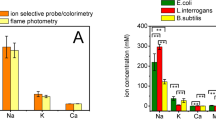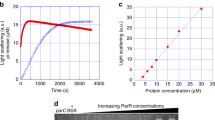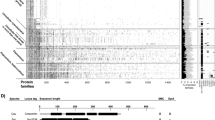Abstract
Bactofilins are small β-helical proteins that form cytoskeletal filaments in a range of bacteria. Bactofilins have diverse functions, from cell stalk formation in Caulobacter crescentus to chromosome segregation and motility in Myxococcus xanthus. However, the precise molecular architecture of bactofilin filaments has remained unclear. Here, sequence analysis and electron microscopy results reveal that, in addition to being widely distributed across bacteria and archaea, bactofilins are also present in a few eukaryotic lineages such as the Oomycetes. Electron cryomicroscopy analysis demonstrated that the sole bactofilin from Thermus thermophilus (TtBac) forms constitutive filaments that polymerize through end-to-end association of the β-helical domains. Using a nanobody, we determined the near-atomic filament structure, showing that the filaments are non-polar. A polymerization-impairing mutation enabled crystallization and structure determination, while reaffirming the lack of polarity and the strength of the β-stacking interface. To confirm the generality of the lack of polarity, we performed coevolutionary analysis on a large set of sequences. Finally, we determined that the widely conserved N-terminal disordered tail of TtBac is responsible for direct binding to lipid membranes, both on liposomes and in Escherichia coli cells. Membrane binding is probably a common feature of these widespread but only recently discovered filaments of the prokaryotic cytoskeleton.
This is a preview of subscription content, access via your institution
Access options
Access Nature and 54 other Nature Portfolio journals
Get Nature+, our best-value online-access subscription
$29.99 / 30 days
cancel any time
Subscribe to this journal
Receive 12 digital issues and online access to articles
$119.00 per year
only $9.92 per issue
Buy this article
- Purchase on Springer Link
- Instant access to full article PDF
Prices may be subject to local taxes which are calculated during checkout






Similar content being viewed by others
Data availability
The data that support the findings of this study are available from the corresponding author, who will also provide all expression plasmids generated for this study on request. Atomic coordinates have been deposited in PDB with accession codes 6RIA and 6RIB. The cryo-EM volume has been deposited in EMDB with accession code EMD-4887.
References
Wagstaff, J. & Löwe, J. Prokaryotic cytoskeletons: protein filaments organizing small cells. Nat. Rev. Microbiol. 16, 187–201 (2018).
Lin, L. & Thanbichler, M. Nucleotide-independent cytoskeletal scaffolds in bacteria. Cytoskeleton 70, 409–423 (2013).
Kühn, J. et al. Bactofilins, a ubiquitous class of cytoskeletal proteins mediating polar localization of a cell wall synthase in Caulobacter crescentus. EMBO J. 29, 327–339 (2010).
Hay, N. A., Tipper, D. J., Gygi, D. & Hughes, C. A novel membrane protein influencing cell shape and multicellular swarming of Proteus mirabilis. J. Bacteriol. 181, 2008–2016 (1999).
Koch, M. K., McHugh, C. A. & Hoiczyk, E. BacM, an N-terminally processed bactofilin of Myxococcus xanthus, is crucial for proper cell shape. Mol. Microbiol. 80, 1031–1051 (2011).
Shi, C. et al. Atomic-resolution structure of cytoskeletal bactofilin by solid-state NMR. Sci. Adv. 1, e1501087 (2015).
Kassem, M. M., Wang, Y., Boomsma, W. & Lindorff-Larsen, K. Structure of the bacterial cytoskeleton protein bactofilin by NMR chemical shifts and sequence variation. Biophys. J. 110, 2342–2348 (2016).
Vasa, S. et al. β-Helical architecture of cytoskeletal bactofilin filaments revealed by solid-state NMR. Proc. Natl Acad. Sci. USA 112, E127–E136 (2015).
Zuckerman, D. M. et al. The bactofilin cytoskeleton protein BacM of Myxococcus xanthus forms an extended β-sheet structure likely mediated by hydrophobic interactions. PLoS ONE 10, e0121074 (2015).
Lin, L., Osorio Valeriano, M., Harms, A., Søgaard-Andersen, L. & Thanbichler, M. Bactofilin-mediated organization of the ParABS chromosome segregation system in Myxococcus xanthus. Nat. Commun. 8, 1817 (2017).
Bulyha, I. et al. Two small GTPases act in concert with the bactofilin cytoskeleton to regulate dynamic bacterial cell polarity. Dev. Cell 25, 119–131 (2013).
Blair, K. M. et al. The Helicobacter pylori cell shape promoting protein Csd5 interacts with the cell wall, MurF, and the bacterial cytoskeleton. Mol. Microbiol. 110, 114–127 (2018).
Sycuro, L. K. et al. Peptidoglycan crosslinking relaxation promotes Helicobacter pylori’s helical shape and stomach colonization. Cell 141, 822–833 (2010).
Jackson, K. M., Schwartz, C., Wachter, J., Rosa, P. A. & Stewart, P. E. A widely conserved bacterial cytoskeletal component influences unique helical shape and motility of the spirochete Leptospira biflexa. Mol. Microbiol. 108, 77–89 (2018).
Gode-Potratz, C. J., Kustusch, R. J., Breheny, P. J., Weiss, D. S. & McCarter, L. L. Surface sensing in Vibrio parahaemolyticus triggers a programme of gene expression that promotes colonization and virulence. Mol. Microbiol. 79, 240–263 (2011).
El Andari, J., Altegoer, F., Bange, G. & Graumann, P. L. Bacillus subtilis bactofilins are essential for flagellar hook- and filament assembly and dynamically localize into structures of less than 100 nm diameter underneath the cell membrane. PLoS ONE 10, e0141546 (2015).
Rajagopala, S. V. et al. The protein network of bacterial motility. Mol. Syst. Biol. 3, 128 (2007).
Mendler, K., Chen, H., Parks, D. H., Hug, L. A. & Doxey, A. AnnoTree: visualization and exploration of a functionally annotated microbial tree of life. Nucleic Acids Res. 47, 4442–4448 (2019).
Parks, D. H. et al. A standardized bacterial taxonomy based on genome phylogeny substantially revises the tree of life. Nat. Biotechnol. 36, 996–1004 (2018).
El-Gebali, S. et al. The Pfam protein families database in 2019. Nucleic Acids Res. 47, D427–D432 (2019).
Ah-Fong, A. M., Kim, K. S. & Judelson, H. S. RNA-seq of life stages of the oomycete Phytophthora infestans reveals dynamic changes in metabolic, signal transduction, and pathogenesis genes and a major role for calcium signaling in development. BMC Genom. 18, 198 (2017).
Bai, X. C., Rajendra, E., Yang, G., Shi, Y. & Scheres, S. H. Sampling the conformational space of the catalytic subunit of human γ-secretase. eLife 4, e11182 (2015).
Ekeberg, M., Lövkvist, C., Lan, Y., Weigt, M. & Aurell, E. Improved contact prediction in proteins: using pseudolikelihoods to infer Potts models. Phys. Rev. E 87, 012707 (2013).
Pichoff, S. & Lutkenhaus, J. Tethering the Z ring to the membrane through a conserved membrane targeting sequence in FtsA. Mol. Microbiol. 55, 1722–1734 (2005).
Salje, J., van den Ent, F., de Boer, P. & Löwe, J. Direct membrane binding by bacterial actin MreB. Mol. Cell 43, 478–487 (2011).
Szeto, T. H., Rowland, S. L., Rothfield, L. I. & King, G. F. Membrane localization of MinD is mediated by a C-terminal motif that is conserved across eubacteria, archaea, and chloroplasts. Proc. Natl Acad. Sci. USA 99, 15693–15698 (2002).
McCarthy, C. G. & Fitzpatrick, D. A. Systematic search for evidence of interdomain horizontal gene transfer from prokaryotes to oomycete lineages. mSphere 1, e00195–16 (2016).
Richards, T. A., Dacks, J. B., Jenkinson, J. M., Thornton, C. R. & Talbot, N. J. Evolution of filamentous plant pathogens: gene exchange across eukaryotic kingdoms. Curr. Biol. 16, 1857–1864 (2006).
Ghosal, D. & Löwe, J. Collaborative protein filaments. EMBO J. 34, 2312–2320 (2015).
Hussain, S. et al. MreB filaments align along greatest principal membrane curvature to orient cell wall synthesis. eLife 7, e32471 (2018).
Lenarcic, R. et al. Localisation of DivIVA by targeting to negatively curved membranes. EMBO J. 28, 2272–2282 (2009).
Gündoğdu, M. E. et al. Large ring polymers align FtsZ polymers for normal septum formation. EMBO J. 30, 617–626 (2011).
Eddy, S. R. Accelerated profile HMM searches. PLoS Comput. Biol. 7, e1002195 (2011).
Mende, D. R. et al. proGenomes: a resource for consistent functional and taxonomic annotations of prokaryotic genomes. Nucleic Acids Res. 45, D529–D534 (2017).
Price, M. N., Paramvir, D. S., Arkin, P. A. & Poon, A. F. Y. FastTree 2 – approximately maximum-likelihood trees for large alignments. PLoS ONE 5, e9490 (2010).
Talavera, G. & Castresana, J. Improvement of phylogenies after removing divergent and ambiguously aligned blocks from protein sequence alignments. Syst. Biol. 56, 564–577 (2007).
Zheng, S. Q. et al. MotionCor2: anisotropic correction of beam-induced motion for improved cryo-electron microscopy. Nat. Methods 14, 331–332 (2017).
Zhang, K. Gctf: Real-time CTF determination and correction. J. Struct. Biol. 193, 1–12 (2016).
Scheres, S. H. RELION: implementation of a Bayesian approach to cryo-EM structure determination. J. Struct. Biol. 180, 519–530 (2012).
He, S. & Scheres, S. H. W. Helical reconstruction in RELION. J. Struct. Biol. 198, 163–176 (2017).
Rosenthal, P. B. & Henderson, R. Optimal determination of particle orientation, absolute hand, and contrast loss in single-particle electron cryomicroscopy. J. Mol. Biol. 333, 721–745 (2003).
Waterhouse, A. et al. SWISS-MODEL: homology modelling of protein structures and complexes. Nucleic Acids Res. 46, W296–W303 (2018).
Afonine, P. V. et al. Real-space refinement in PHENIX for cryo-EM and crystallography. Acta Crystallogr. D 74, 531–544 (2018).
van den Ent, F., Lockhart, A., Kendrick-Jones, J. & Löwe, J. Crystal structure of the N-terminal domain of MukB: a protein involved in chromosome partitioning. Structure 7, 1181–1187 (1999).
Stock, D., Perisic, O. & Löwe, J. Robotic nanolitre protein crystallisation at the MRC Laboratory of Molecular Biology. Prog. Biophys. Mol. Biol. 88, 311–327 (2005).
Winn, M. D. et al. Overview of the CCP4 suite and current developments. Acta Crystallogr. D 67, 235–242 (2011).
Sheldrick, G. M. A short history of SHELX. Acta Crystallogr. A 64, 112–122 (2008).
Read, R. J. & McCoy, A. J. Using SAD data in Phaser. Acta Crystallogr. D 67, 338–344 (2011).
Turk, D. MAIN software for density averaging, model building, structure refinement and validation. Acta Crystallogr. D 69, 1342–1357 (2013).
Adams, P. D. et al. PHENIX: a comprehensive Python-based system for macromolecular structure solution. Acta Crystallogr. D 66, 213–221 (2010).
Mastronarde, D. N. Automated electron microscope tomography using robust prediction of specimen movements. J. Struct. Biol. 152, 36–51 (2005).
Hagen, W. J. H., Wan, W. & Briggs, J. A. G. Implementation of a cryo-electron tomography tilt-scheme optimized for high resolution subtomogram averaging. J. Struct. Biol. 197, 191–198 (2017).
Kremer, J. R., Mastronarde, D. N. & McIntosh, J. R. Computer visualization of three-dimensional image data using IMOD. J. Struct. Biol. 116, 71–76 (1996).
Derelle, R., Purificación, L. -G., Timpano, H. & Moreira, D. A phylogenomic framework to study the diversity and evolution of stramenopiles (=Heterokonts). Mol. Biol. Evol. 33, 2890–2898 (2016).
Acknowledgements
We thank H. S. Judelson (UC Riverside) for discussions regarding Oomycetes. We acknowledge Diamond Light Source for the cryo-EM facilities at eBIC. We thank M. Yu (MRC−LMB) for help with synchrotron data collection and the staff at beamline I03 (Diamond Light Source). This work was funded by the MRC (grant no. U105184326 to J.L.) and the Wellcome Trust (grant no. 202754/Z/16/Z to J.L.). J.W. and X.D. were also supported by the Boehringer Ingelheim Fonds.
Author information
Authors and Affiliations
Contributions
X.D., A.G.L. D.K.-C. and J.L. performed the protein purification experiments. X.D., A.G.L., G.C. and J.L. collected the cryo-EM data and processed the images. A.G.L. and J.L. performed the crystallization and crystallography. J.M.W. performed the phylogeny and coupling analyses. V.L.H. performed the cryo-ET experiments. S.H.M. and A.G.L. performed the SPR experiments and analyses. A.G.L., J.M.W. and J.L. wrote the manuscript.
Corresponding author
Ethics declarations
Competing interests
The authors declare no competing interests.
Additional information
Publisher’s note: Springer Nature remains neutral with regard to jurisdictional claims in published maps and institutional affiliations.
Supplementary Information
Supplementary Information
Supplementary Figs. 1−6, Tables 1−3, Supplementary Video legends, Dataset 2 legend and Supplementary References.
Supplementary Dataset 2
Eukaryotic bactofilins.
Supplementary Video 1
The cryo-EM density after helical reconstruction of a TtBac filament bound by NB4-mut2. Boundaries of the bactofilin monomers are clearly visible, as is their antiparallel arrangement in each protofilament. An image from this video is shown in Fig. 3f.
Supplementary Video 2
An overview of the TtBac cryo-EM structure, providing a better 3D impression of the assembly.
Supplementary Video 3
Cryo-ET of an E. coli cell with TtBac-WT overexpressed. Filament bundles are arranged all around the cell’s periphery, under the inner membrane, and are particularly obvious when the video goes through the upper and lower cellular envelope where the bactofilin bundles run at roughly 45° angles to the long cell axis. Images from the tomogram are shown in Fig. 6e (left).
Supplementary Video 4
The same as Supplementary Video 3, but ΔN-TtBac has been overexpressed. Because the filaments no longer bind to the inner membrane of the E. coli cells, a very large bactofilin bundle runs along the long cell axis, also inhibiting cell division at the septum site. An image from this tomogram is shown in Fig. 6e (right).
Rights and permissions
About this article
Cite this article
Deng, X., Gonzalez Llamazares, A., Wagstaff, J.M. et al. The structure of bactofilin filaments reveals their mode of membrane binding and lack of polarity. Nat Microbiol 4, 2357–2368 (2019). https://doi.org/10.1038/s41564-019-0544-0
Received:
Accepted:
Published:
Issue Date:
DOI: https://doi.org/10.1038/s41564-019-0544-0
This article is cited by
-
Strain-dependent motility defects and suppression by a flhO mutation for B. subtilis bactofilins
BMC Research Notes (2022)
-
Architecture of the flexible tail tube of bacteriophage SPP1
Nature Communications (2020)



